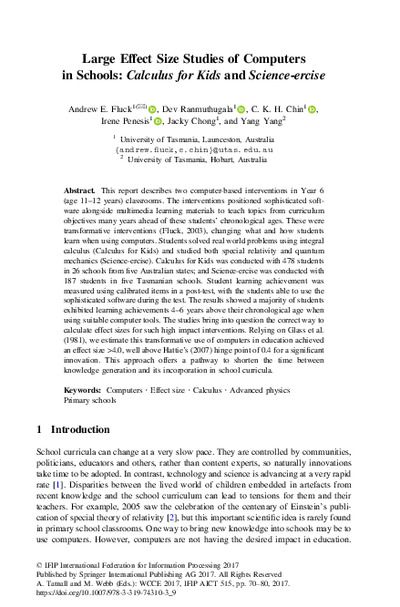Large Effect Size Studies of Computers in SchoolsCalculus for Kids and Science-ercise
Andrew Fluck, Dev Ranmuthugala, C. K. H. Chin, Irene Penesis, Jacky Chong, Yang Yang
Zu finden in: Tomorrow's Learning: Involving Everyone. Learning with and about Technologies and Computing (Seite 70 bis 80), 2017
  |
 |
 Diese Seite wurde seit 3 Jahren inhaltlich nicht mehr aktualisiert.
Unter Umständen ist sie nicht mehr aktuell.
Diese Seite wurde seit 3 Jahren inhaltlich nicht mehr aktualisiert.
Unter Umständen ist sie nicht mehr aktuell.
 Zusammenfassungen
Zusammenfassungen
 This report describes two computer-based interventions in Year 6 (age 11–12 years) classrooms. The interventions positioned sophisticated software alongside multimedia learning materials to teach topics from curriculum objectives many years ahead of these students’ chronological ages. These were transformative interventions (Fluck, 2003), changing what and how students learn when using computers. Students solved real world problems using integral calculus (Calculus for Kids) and studied both special relativity and quantum mechanics (Science-ercise). Calculus for Kids was conducted with 478 students in 26 schools from five Australian states; and Science-ercise was conducted with 187 students in five Tasmanian schools. Student learning achievement was measured using calibrated items in a post-test, with the students able to use the sophisticated software during the test. The results showed a majority of students exhibited learning achievements 4–6 years above their chronological age when using suitable computer tools. The studies bring into question the correct way to calculate effect sizes for such high impact interventions. Relying on Glass et al. (1981), we estimate this transformative use of computers in education achieved an effect size >4.0, well above Hattie’s (2007) hinge point of 0.4 for a significant innovation. This approach offers a pathway to shorten the time between knowledge generation and its incorporation in school curricula.
This report describes two computer-based interventions in Year 6 (age 11–12 years) classrooms. The interventions positioned sophisticated software alongside multimedia learning materials to teach topics from curriculum objectives many years ahead of these students’ chronological ages. These were transformative interventions (Fluck, 2003), changing what and how students learn when using computers. Students solved real world problems using integral calculus (Calculus for Kids) and studied both special relativity and quantum mechanics (Science-ercise). Calculus for Kids was conducted with 478 students in 26 schools from five Australian states; and Science-ercise was conducted with 187 students in five Tasmanian schools. Student learning achievement was measured using calibrated items in a post-test, with the students able to use the sophisticated software during the test. The results showed a majority of students exhibited learning achievements 4–6 years above their chronological age when using suitable computer tools. The studies bring into question the correct way to calculate effect sizes for such high impact interventions. Relying on Glass et al. (1981), we estimate this transformative use of computers in education achieved an effect size >4.0, well above Hattie’s (2007) hinge point of 0.4 for a significant innovation. This approach offers a pathway to shorten the time between knowledge generation and its incorporation in school curricula. Dieses Kapitel erwähnt ...
Dieses Kapitel erwähnt ...
 Personen KB IB clear | Gene V. Glass , John Hattie , Ray Kurzweil , Barry McGaw , E. M Rogers , Mary Lee Smith | |||||||||||||||||||||||||||||||||||||||||||||
 Fragen KB IB clear | Warum ICT in der Schule?Why ICT in schools? | |||||||||||||||||||||||||||||||||||||||||||||
 Begriffe KB IB clear |  Computer Computer computer
, Effektstärkeeffect size
, computer
, Effektstärkeeffect size
,  Lernen Lernen learning
, learning
,  Multimedia Multimedia multimedia
, multimedia
,  SAMR-Model
, SAMR-Model
,  Software Software software software
| |||||||||||||||||||||||||||||||||||||||||||||
 Bücher |
| |||||||||||||||||||||||||||||||||||||||||||||
 Texte |
|
 Dieses Kapitel erwähnt vermutlich nicht ...
Dieses Kapitel erwähnt vermutlich nicht ... 
 Nicht erwähnte Begriffe | Metaanalyse, Schule |
 Zitationsgraph
Zitationsgraph
 Zitationsgraph (Beta-Test mit vis.js)
Zitationsgraph (Beta-Test mit vis.js)
 Anderswo finden
Anderswo finden
 Volltext dieses Dokuments
Volltext dieses Dokuments
 |  Large Effect Size Studies of Computers in Schools: Artikel als Volltext bei Springerlink ( Large Effect Size Studies of Computers in Schools: Artikel als Volltext bei Springerlink ( : :  , 704 kByte; , 704 kByte;  : :  ) ) |
 Anderswo suchen
Anderswo suchen 
 Beat und dieses Kapitel
Beat und dieses Kapitel
Beat hat Dieses Kapitel während seiner Zeit am Institut für Medien und Schule (IMS) ins Biblionetz aufgenommen. Beat besitzt kein physisches, aber ein digitales Exemplar. Eine digitale Version ist auf dem Internet verfügbar (s.o.). Es gibt bisher nur wenige Objekte im Biblionetz, die dieses Werk zitieren.













 Biblionetz-History
Biblionetz-History